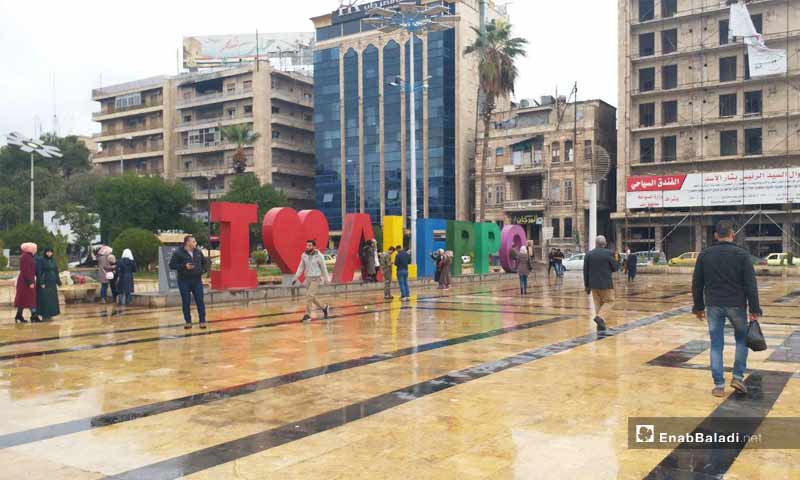Between the headquarters of the Arab Socialist Baath Party in Aleppo and the Aleppo Officers Club, national figure Saadallah al-Jabiri loses the features of his long history of struggle. Instead, Al-Jabiri became little more than a “square” surrounded by pro-regime militias in which to hold “resistance” parades, and a space that can accommodate larger billboards of Assad.
Saadallah al-Jabiri Square geographically represents Aleppo’s ancient “city center” and culturally chronicles the struggle of one of the most prominent political figures in modern Syrian history. Today, however, it is no longer represents anything but a tribute to the city’s loyalty to Assad.
During the years of control by opposition factions over the eastern districts of Aleppo, between 2012 and 2016, the square became a target of repeated attacks by these factions, and reaching it was tantamount to penetrating Syria’s second-largest city and its economic capital.
Today, two and a half years after the departure of the opposition factions from East Aleppo, the square became a venue for various events linked to the regime or its auxiliary forces and militias. These include the “I Love Aleppo” celebration which was held by the Ministry of Tourism in September 2017, and most recently, Quds Day celebrations sponsored by the Baath party branch in early June.
“Occupation” in Front of Al-Jabri’s Watchful Eyes
Among the most prominent events witnessed in this square was the 73rd anniversary of the Soviet Army’s victory over Nazi forces in World War II, which was held on September 5, 2018. Russian soldiers, alongside the regime, attended the event which saw Russian anthems and marches, and chants by the “masses” expressing “appreciation by the Syrian people to Russia and gratitude in the light of the absolute support they offered to strengthen their steadfastness.”
This ceremony reflects the consolidation of Russian presence in Syria and a celebration of it. Meanwhile, historical references to the namesake of this square speaks of his opposition and rejection of occupation, as Saadullah al-Jabiri (1893-1947) resisted French presence in Syria since 1919 until its expulsion from Syria, and later served as prime minister twice in 1944 and 1946, according to historian Mohammed al-Jawadi.
Although al-Jabri was honored after his death in 1947, and was a long history of struggle was broadly celebrated. However, this celebration did not last in the post-Baath period. While Aleppo’s largest square was named after al-Jabiri, his likeness was not known to most of the city’s residents.
Since the late 1990s, the only photos that can be seen decorating this major square were those of the two Assads, the father and the son. What is absent from the scene, however, is the small statue that embodies al-Jabiri, located at the edge of the square.
Node between East and West
Opposition factions, during their control of the eastern neighborhoods of Aleppo, did not succeed in reaching Saadallah al-Jabiri Square. Although their positions were not far from the square, and are estimated at less than 2.5 kilometers away according to Google Maps indicators, the square remained the dividing line between the two military forces controlling the city.
The 170 m2 square remained the node between West and East Aleppo. To its west are the neighborhoods of Jamiliyah and beyond, where the city’s modern neighborhoods are located such as al-Sabil and al-Nil and al-Furqan. To its east, and south-east, are Al-Walid Street and al-Hal Market, Bab Antakia Street all the way to the Citadel of Aleppo.
In addition to its location as a gateway to the western neighborhoods of the city, the importance of the square to opposition factions emerged because of the heavy presence of government and security headquarters around it. Therefore, it was targeted several times, most notably by three car bombs targeting the Aleppo Officers Club in October 2012, killing 35 people, which deformed the features of the Club and the touristic hotel next to it, and damaged the square as well.
Promises of the opposition to reach the square were a form of psychological warfare against regime loyalists. Perhaps the most notable of these promises were uttered by Saudi preacher Abdullah al-Muhaisini, who appeared in a video published in August 2016 wandering in the eastern neighborhoods of Aleppo, and promising that his next speech will be from Saadallah Al-Jabiri Square.
Despite the disconnect between the two sides of Aleppo, with the regime reclaiming the entire city in 2016, areas east of the square remain different from its west, as evidenced by the piles of rubble and destruction which remain to this day, which are directly visible to those passing by Saadallah Al-Jabiri towards the east.

